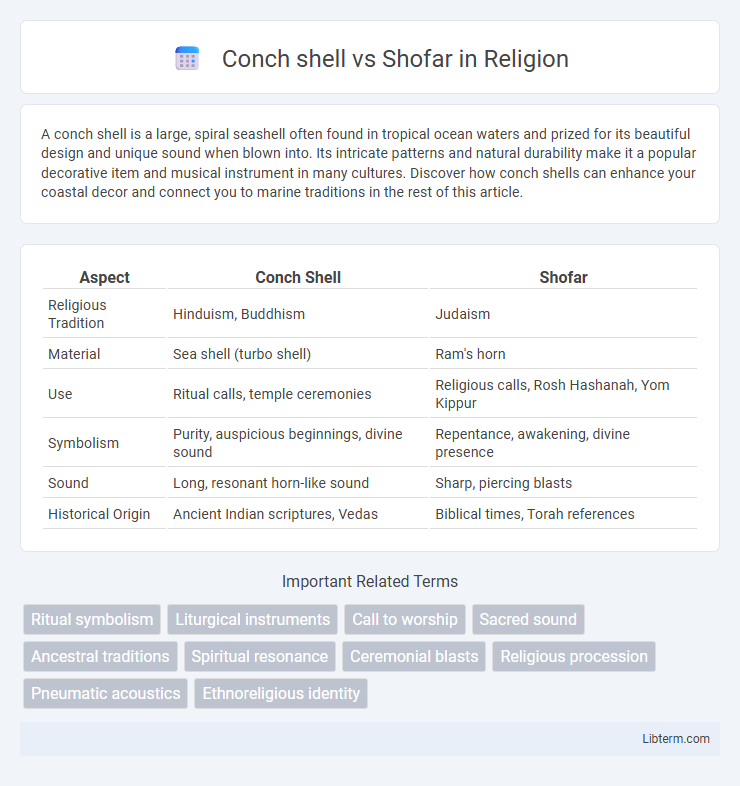A conch shell is a large, spiral seashell often found in tropical ocean waters and prized for its beautiful design and unique sound when blown into. Its intricate patterns and natural durability make it a popular decorative item and musical instrument in many cultures. Discover how conch shells can enhance your coastal decor and connect you to marine traditions in the rest of this article.
Table of Comparison
| Aspect | Conch Shell | Shofar |
|---|---|---|
| Religious Tradition | Hinduism, Buddhism | Judaism |
| Material | Sea shell (turbo shell) | Ram's horn |
| Use | Ritual calls, temple ceremonies | Religious calls, Rosh Hashanah, Yom Kippur |
| Symbolism | Purity, auspicious beginnings, divine sound | Repentance, awakening, divine presence |
| Sound | Long, resonant horn-like sound | Sharp, piercing blasts |
| Historical Origin | Ancient Indian scriptures, Vedas | Biblical times, Torah references |
Introduction: Conch Shell vs Shofar
The conch shell and shofar are both traditional wind instruments with deep cultural and religious significance, originating from different regions and faiths. The conch shell, often associated with Hindu rituals and maritime cultures, produces a powerful, resonant sound used to mark sacred moments. The shofar, made from a ram's horn, holds a central role in Jewish religious ceremonies, especially during Rosh Hashanah and Yom Kippur, symbolizing spiritual awakening and repentance.
Historical Origins and Cultural Significance
The conch shell, used as a horn in Hindu and Buddhist rituals, dates back to ancient India, symbolizing divine sound and spiritual awakening, while the shofar, traditionally made from a ram's horn, originates from ancient Israel and holds deep significance in Jewish religious ceremonies such as Rosh Hashanah and Yom Kippur. Both instruments serve as powerful sonic symbols -- the conch shell calling communities to worship or signaling sacred moments, and the shofar representing a call to repentance and divine presence. Their historical origins reflect distinct cultural narratives, intertwining mythology, religious practice, and communal identity.
Physical Characteristics and Structure
The conch shell, typically sourced from large marine mollusks, features a naturally spiraled and ridged exterior with a hard, calcified structure that produces a deep, resonant sound when blown. The shofar, traditionally crafted from the horn of a ram, presents a curved, hollowed form with a smooth, polished surface that enhances its distinctive tonal quality used in Jewish religious ceremonies. Both instruments rely on their unique horn-like shapes and openings to create sound, but the conch shell's organic spiral contrasts with the shofar's simpler, more uniform curve.
Methods of Sound Production
The conch shell produces sound by buzzing the lips against its natural mouthpiece, creating a deep, resonant tone amplified through its spiral chamber. In contrast, the shofar, made from a ram's horn, generates sound by the player blowing air through its narrow, curved opening, causing vibrations that result in a piercing, sharp blast. Both instruments rely on lip vibration and airflow manipulation but differ in material structure and tonal quality influenced by their unique shapes.
Symbolic Meanings in Different Traditions
The conch shell, revered in Hinduism and Buddhism, symbolizes purity, the voice of divinity, and the call to awaken spiritual consciousness. The shofar, a ram's horn used in Jewish tradition, represents a call to repentance, divine intervention, and the proclamation of sacred festivals such as Rosh Hashanah and Yom Kippur. Both instruments serve as powerful ritualistic tools embodying spiritual awakening and connection to the divine, yet their symbolic meanings are deeply rooted in their respective cultural and religious contexts.
Use in Rituals and Ceremonies
The conch shell, primarily used in Hindu and Buddhist rituals, serves as a ceremonial trumpet symbolizing auspiciousness and the call to worship, often blown during temple ceremonies and religious festivals. The shofar, a ram's horn integral to Jewish traditions, is sounded during Rosh Hashanah and Yom Kippur to mark a call to repentance and spiritual awakening. Both instruments function as powerful auditory symbols in their respective cultures, embodying spiritual significance and communal identity through ritual use.
Geographic Distribution and Popularity
The conch shell is traditionally used as a trumpet across coastal regions in the Caribbean, South Asia, and the Pacific Islands, where it holds ceremonial and cultural significance. The Shofar, made from a ram's horn, is primarily found in Jewish communities worldwide, especially in Israel, the United States, and parts of Europe, where it remains an essential element in religious rituals like Rosh Hashanah and Yom Kippur. While the conch shell enjoys broader usage in indigenous and regional ceremonies, the Shofar maintains a focused religious relevance with a strong presence in the Jewish diaspora.
Notable Appearances in Literature and Art
The conch shell, symbolizing awakening and authority, prominently appears in Herman Melville's *Moby-Dick* as a tool of order and civilization. The shofar, a ram's horn, holds deep religious significance and frequently features in Jewish sacred texts and visual art, symbolizing calls to repentance and divine presence. Both objects serve as powerful cultural motifs, with the conch shell linked to maritime and tribal rites, and the shofar central to Jewish ritual and prophetic literature.
Conservation and Ethical Considerations
Conch shells, often sourced from marine environments, raise significant conservation concerns due to overharvesting and habitat disruption, threatening mollusk populations and biodiversity. In contrast, the shofar, traditionally made from ram's horn, involves ethical considerations centered on animal welfare and sustainable sourcing without significant ecological impact. Both items require mindful practices to balance cultural significance with environmental and ethical responsibilities.
Conclusion: Comparing Legacy and Impact
The conch shell and shofar both serve as powerful auditory symbols rooted in ancient traditions, with the shofar deeply embedded in Jewish religious rituals while the conch shell holds significant spiritual and cultural roles in Hinduism and indigenous cultures. Their legacies endure through centuries, emphasizing identity, communication, and ceremonial importance within their respective societies. Each instrument's impact transcends mere sound, resonating as a call to unity, remembrance, and spiritual awakening.
Conch shell Infographic

 libterm.com
libterm.com